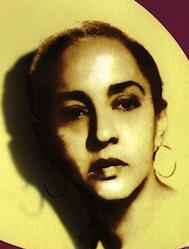


María Teresa Vera
Source: Artemiseno
Launching the Caribbean portion of the HMR Project is Maria Teresa Vera. Dominating the music of that region was Cuba prior to Fidel Castro who became Prime Minister in 1959. Puerto Rico was also a hot spot. The musical link between the Caribbean and the United States is pronounced in jazz, percussion distinctive in that via such as maracas originating in Puerto Rico. Bongos and congas were imported to the Caribbean from Africa. Timbales had arrived from Spain.
Elemental to Cuban music is son, a broad category developing out of the mixture of European music via Spain and African rhythms brought to Cuba by the slave trade. Roughly half of Ciba's population prior to the 20th century were slaves. The national dance of Cuba, the danzon, was also an import from Spain. The famous Cuban form called the rumba also found its way to Mexico City which was relatively isolated compared to pre-revolution Havana which was the place to be for hep cats from the States. The earliest reference to the rumba on record was in 1899 on an Edison cylinder, 'Los Rumberos' by Arturo B. Adamini. The first use of the word "rumba" on a record label was in 1905: 'La Rumba', credited to the Orquesta Típica Velázquez for Victor (thought composed in Guadalajara, Mexico, by Cuban musician, Fernando Méndez Velázquez). The first appearance of the word "guaguancó" (rumba subgenre) is 'Guaguancó', by the Orquesta Reverón in 1918. The initial rumba to feature vocals is said to be 'Se Acabó la Rumba' by the Orquesta Felipe Valdéz in 1920. The first traditional rumba recorded is said to be 'El Yambú Guaguancó', circa 1920, by Manuel Corona & María Teresa Vera [Vamos a Guarachar].
The migration of Caribbean performers to the United States was largely to record in New York City, as recording studios down south were as sparse as technologically arear. Nor was there the ability to distribute discs, concerning which record companies in the United States were wizards with global reach. One important example of the interweaving of Cuban rhythms with American jazz is Dizzy Gillespie's collaborations with Afro-Cuban musicians, Mario Bauza and Chano Pozo, as of the forties. Salsa (sauce) followed later, that arriving in the sixties.
María Teresa Vera was a guitarist and vocalist born in Guanajay, Cuba, on 6 February 1895 to become a highly popular trova musician. The trova is a song by a trovador, an itinerate musician, usually a singing guitarist. Troubadour is the French for the roaming musician arriving in the twelfth century. A similar practice in modern times is called busking, more at street corner performing whether traveling or not. Credited w creating the trova as it came to be known is Pepe Sanchez who further developed trova into the Cuban bolero, that of distinct origin from the Spanish bolero with which it oughtn't be confused. Boleros were in general slow-tempo sentimental songs. An apt example of the Cuban bolero having developed out of trova is Vera's own composition of 1935, 'Veinte Anos' ('Twenty Years').
Vera began singing in an Havana theatre in 1911. She learned guitar fundamentals from Manuel Corona before forming a partnership with Rafael Zequeira in 1916, the year she also first recorded. The pair put away more than a hundred sessions together before Zequeira's death in 1964. In 1918 Vera put down titles with Carlos Godinez' Sexteto Habanero Godínez. In 1925 she formed the Sexteto Occidente with Miguel García. She began partnering with Lorenzo Hierrezuelo in 1935.
'Te Revolviste Cayuco' Vera w Rafael Zequeira Matrix G-2590 Victor 72078
DAHR: Recorded Feb 7 1918 in Havana (NYC is more likely)
DAHR credits Jose Corona w composition who probably Manuel Corona
'El Servicio Obligatorio' Vera w Rafael Zequeira Matrix G-2591 Victor 69947 A
DAHR: Recorded Feb 7 1918 in Havana (NYC is more likely)
DAHR credits Jose Corona w composition who is probably Manuel Corona
'Acelera Ñico Acelera' Vera w Rafael Zequeira Matrix G-2592 Victor 69947 B
DAHR: Recorded Feb 7 1918 in Havana (NYC is more likely)
This is described as a guaracha rumba.
DAHR credits Jose Corona w composition who is probably Manuel Corona
'El Yambú Guaguancó' Vera w Manuel Corona Columbia C3557 Circa 1920
The guaguancó and yambu are subgenres of rumba.
'Veinte Años' Vera w Lorenzo Hierrezuelo 1956
Music: Vera Lyrics: Guillermina Aramburu 1935
Vera died in Havana on 17 December of 1965. The major portion of her recordings haven't survived. Of what is left, a couple of CDs have been compiled by Tumbao, one featuring her recordings with Zequeira from 1916 to 1924, another in 1926 with the Sexteto Occidente.
Sources & References: Music of the Caribbean:
The Danzon:
Latin Jazz:
Son:
Further Reading:
Tim Johnson (the danzon)
Piero Scaruffi (Latin American popular music)
Vamos a Guarachar
Sources & References: María Teresa Vera:
The Bolero:
The Bolero Cuban (irrelevant to the Spanish bolero):
Compilations:
El Legendario Dúo De La Trova Cubana (w Zequeira 1916-1924 on Tumbao TCD 090)
Discographies:
The Guaguancó (form of rumba):
The Guaracha (form of trova):
Pepe Sanchez:
Wikipedia
Sessionographies:
Sexteto Habanero Godínez:
Vera in Soundtracks:
Further Reading:
The Bolero Spanish (irrelevant to Cuban):
Havana Music School (Cuban bolero)
HeyPally (Vera w Rafael Zequeira)
Carlos Quintana (Cuban bolero)
Classical Main Menu Modern Recording
|
|
hmrproject (at) aol (dot) com